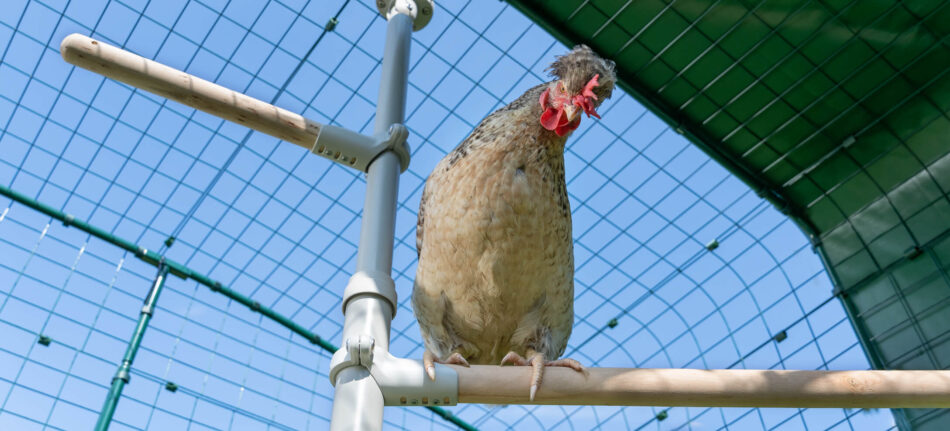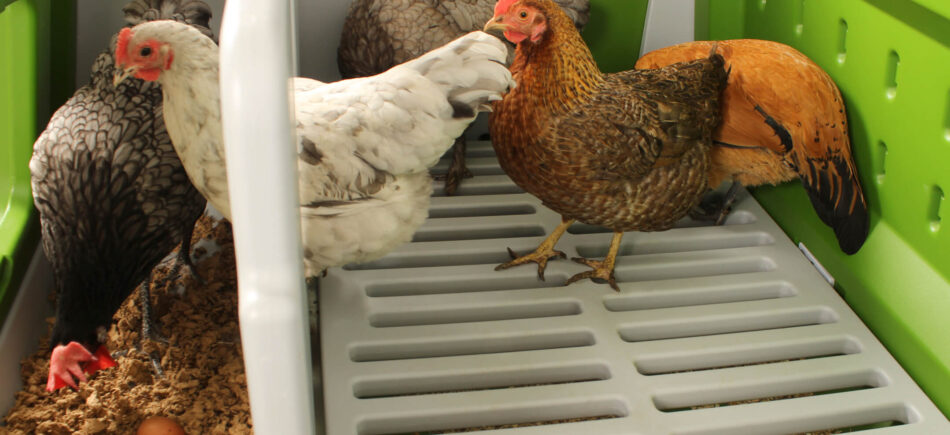Chicken Perches – The Ultimate Guide
Like the absolute majority of birds, chickens love to perch. It’s one of the strongest natural instincts they have, and something that makes them feel safe, while also providing comfort and stimulation. But while wild birds will have to do with branches, telephone wires and garden chairs, you should make sure your flock have perches that are made especially for chicken feet, to make sure they stay happy and healthy both day and night. Read on to get all your perching questions answered!

Table of Contents
Why do chickens need perches?
Perching is one of the strong instincts that domesticated chickens still very much have, and you will find chickens, just like all other birds, seeking out places off the ground to sit and relax.
Having a perch means hens feel safe while sleeping next to their friends, and it’s important to provide them with this sense of security both inside and outside of their coop. In fact, perching is a recognised welfare need of all birds, and European law insists on perches, even for caged birds.
What shape should a chicken perch have?
This depends slightly on how long the chickens are spending sitting on the perch or roosting bar. Unlike most other birds, chickens sleep with their feet resting flat, and a handy locking mechanism curls only the toes around the perch so they don’t fall off when drifting off to sleep.
When chickens settle in for the night they rest their keel bones (the bone on the breast) on the perch as well as their feet, which spreads the pressure from the birds’ weight. If the perch is sharp or very bumpy, this can put the pressure balance off which can lead to sores on the feet, and rubbing the keel bone against an uneven, rough surface can irritate the skin. That’s why it’s best to have a flat, smooth perch for roosting.
Perches put on the chicken run or elsewhere in the garden that are not specifically used for sleeping, but rather as somewhere the bird can sit for a quick nap or to see what is going on around them, can be rounder and rougher. This is simply because the chickens won’t spend as long on them in one sitting. You can put up some branches for your flock to rest on, but if you want something custom made the Omlet Chicken Perch can be attached at any height, to any surface, and is the perfect size for the absolute majority of hens.
How much perch space should each chicken have?
You should calculate 20-25cm perch space per bird, but large birds might require a bit more, and bantams less, so it depends a bit on the flock. At night, especially in winter, you will find that the chickens huddle together into one feathery ball to help each other stay warm, but to prevent aggressive behaviour, and to keep your flock cool in warmer weather, it’s important to give each bird enough perching space.
How thick should a chicken perch be?
The ideal perch size varies slightly depending on what breed of chicken you have, but somewhere between 2cm and 5cm suits most hens. For roosting bars, don’t go wider than around 8cm, as the birds will then struggle to grip the perch with their back toes, and can find it hard to keep their balance while sleeping.

What material should a chicken perch be made of?
The important thing here is to assure that the perch will be safe to touch in all temperatures, and that the perch is smooth but still has grip. For example, chickens’ feet can literally freeze to a metal perch in the depths of winter, and some plastic materials run the risk of cracking in the cold and melting in the heat.
Strong, untreated wood is the most common material for chicken roosting bars, such as eucalyptus, the material used for the perches of Omlet’s Chicken PoleTree. A good quality plastic that isn’t too slippery has the added benefit of being very easy to wipe clean. The roosting bars in the Eglu Chicken Coops have a structured pattern on top of the flat bar with rounded edges, which provides grip and stability.
How high should roosting bars be placed?
You often hear that wild chickens perch high up in trees, and it’s natural to think that would be the dream scenario for your flock as well. But domesticated backyard chickens of today are far from the wild jungle fowl they descend from, and although they like perching off the ground, most don’t need to be particularly high, especially not while sleeping.
In fact, keeping perches too far off the ground can increase the risk of injuries when the hens jump down from the bars, especially risky for elderly or recently rescued hens. So as long as they have something to grip, and aren’t sitting on the unsanitary floor of the coop, most birds will be happy.
Should chicks have perches?
Yes. Chicks start exploring their surroundings and jumping onto higher surfaces from the age of three days, so even though they most likely won’t roost on the perches, it’s a good idea to provide them with something to perch on early on to get them used to it. It’s also good for their bones, and teaches them how to safely hold onto a perch.
With this being said, don’t provide your chicks with high perches, as you don’t want them to jump before their bones have properly formed. Start with something on the floor, and raise gradually as the chicks grow.
This entry was posted in Chickens